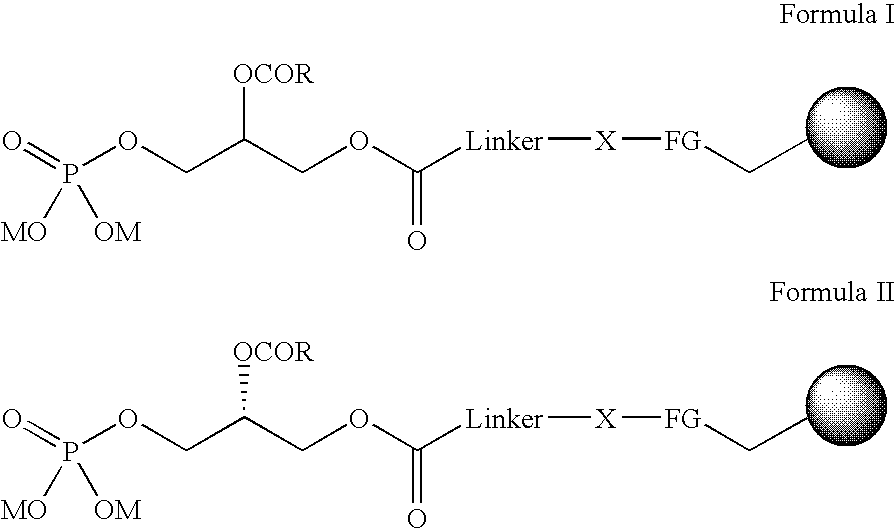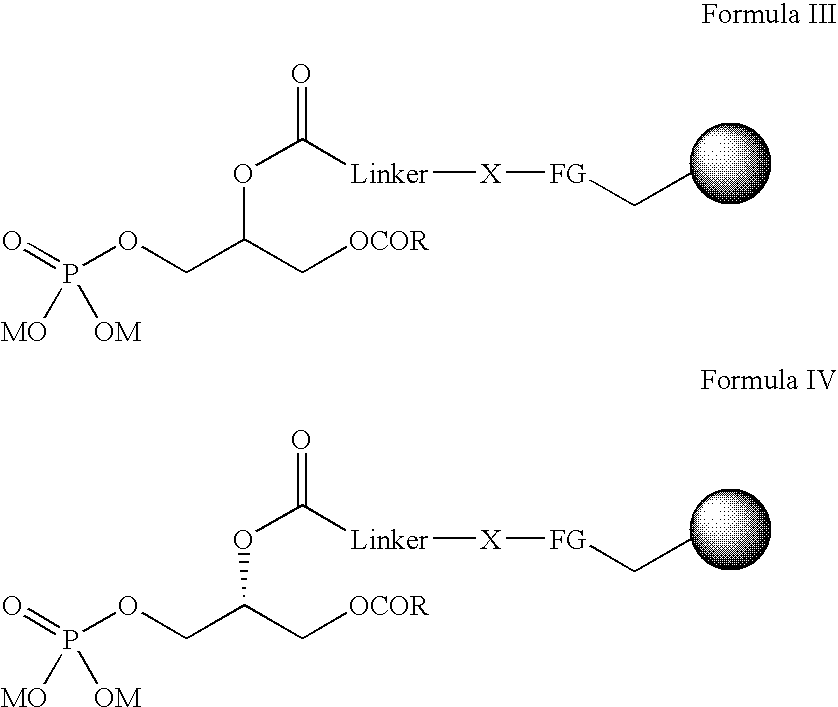Immobilised phosphatidic acid probe
a phosphatidic acid probe and probe technology, applied in the field of immobilised phosphatidic acid probes, can solve the problems of unstable pa in cells, difficult to identify detergent-extracted pa-binding proteins, and difficult to handle free pa (both synthetic or biological origins)
- Summary
- Abstract
- Description
- Claims
- Application Information
AI Technical Summary
Problems solved by technology
Method used
Image
Examples
first embodiment
The First embodiment
[0211] Proteins of known identity and function but whose exact mechanism of action is not well understood. Kinesin, N-ethylmaleimide-sensitive factor (NSF), coatomer and ADP ribosylation factor (Arf) of the PA binding proteins identified so far using the PA resin fall into this category. We will briefly discuss kinesin as an example but similar arguments can be made for the rest of the known proteins. Membrane vesicle and organelle movement in eucaryotic cells is driven along microtubules by motor proteins [Rogers and Gelfand, Current Opinion in Cell Biology 12: 57-62 (2000)]. Kinesins, which are among the best understood of those motor proteins, hydrolyse ATP to generate movement along microtubules [Sablin, Current Opinion in Cell Biology 12: 3541 (2000)]. Part of the kinesin molecule has been crystalised, and mice carrying targeted knockouts for conventional kinesin have been generated. Thus the kinesin field is very advanced. However, the exact mechanism by wh...
second embodiment
The Second Embodiment
[0212] Proteins of known identity but whose function is not understood. Neurochondrininorbin, a PA binding protein identified using the PA resin falls into this category. The gene for this protein was found to be upregulated following treatment of rat hippocampal slices with tetraethylammonium, a compound that induces long-term potentiation-like synaptic enhancement [Shinozaki et al. Biochem. Biophys. Res. Comm. 240: 766-771 (1997)]. Subsequent work has shown that norbin is present in dendrites of neural outgrowth [Shinozaki et al. Molecular Brain Research 71: 364-368 (1999)] whereas independent work based on expression cloning has indicated an additional role for this protein in bone metastasis [Ishizuka et al. Biochim. Biophys. Acta 1450: 92-98 (1999)]. For such a protein and others to be identified, discovery of their PA binding property may provide important clues as to their function and should help to design experiments to elucidate this function. For thos...
third embodiment
The Third Embodiment
[0213] Totally Novel Proteins.
Scope of the Invention
[0214] The PA resin described above and the PIPn resins described below are general analytical tools for identification of additional PA-binding or PIPn-binding proteins from different tissues and biological fluids. We envisage that the cytosolic and membrane contents of any cell type can be screened for PAIPIPn binding proteins using these resins. (In addition to brain, a partial list includes liver, kidney, heart, pancreas, macrophages, neutrophils.) In all cases, cytosolic or membrane fractions could be subjected to assays as described above. Once a series of proteins, which bind directly to PA or PIPn, have been identified, they could be examined as to which amino acids are involved in the binding, using a photoaffinity labeled PA-analogue (see above) or PIPn analogue. Comparison among those proteins should result in a common motif which may define the PA binding motif or a PIPn binding motif. Once the motif...
PUM
| Property | Measurement | Unit |
|---|---|---|
| pH | aaaaa | aaaaa |
| pressure | aaaaa | aaaaa |
| pH | aaaaa | aaaaa |
Abstract
Description
Claims
Application Information
 Login to View More
Login to View More - R&D
- Intellectual Property
- Life Sciences
- Materials
- Tech Scout
- Unparalleled Data Quality
- Higher Quality Content
- 60% Fewer Hallucinations
Browse by: Latest US Patents, China's latest patents, Technical Efficacy Thesaurus, Application Domain, Technology Topic, Popular Technical Reports.
© 2025 PatSnap. All rights reserved.Legal|Privacy policy|Modern Slavery Act Transparency Statement|Sitemap|About US| Contact US: help@patsnap.com



